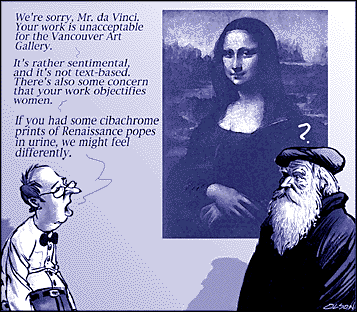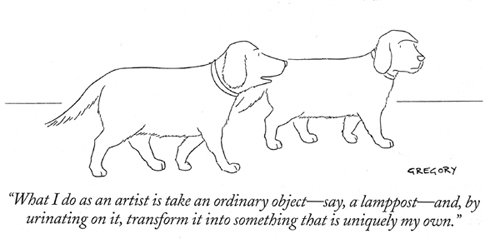| Home | Exhibitions | About | Videos |
WCFMA | Music Site | Links |  |
Contact |
| Home | Exhibitions | About | Videos |
WCFMA | Music Site | Links |  |
Contact |
In art, the prime history-makers are painters and sculptors. As
indicated
earlier , there are writers
and cultural commissars who wish to appropriate this privilege of the
artist
and to use him as an
instrument for their own art-history-making. The result is a new
kind of conflict - between the artist
and the professional representatives of his public.
Art criticism today is beset by art historians turned inside out to
function
as prophets of so-called
inevitable trends. A determinism similar to that projected into
the
evolution of past styles is clamped
upon art in the making. In this parody of art history, value
judgments
are deduced from a presumed
logic of development, and an ultimatum is issued to artists either to
accommodate
themselves to these
values or be banned from the art of the future. An aesthetician founded
on art history wields a club of
dogma similar to moralistic criticism in the nineteenth century or
political
criticism in the Soviet Union.
After 1972 anyone could be an artist, except, perhaps, painters and
sculptors.
No degree of dullness can
safeguard a work
against the determination of critics to find it fascinating.
Moreover, its new position of power led the museum to develop its own
version
of bureaucratic
corruption: favoritism in buying and showing, falsification of recent
art
history, using museum
prestige to enhance investments by trustees, secret deals in the
acquisition
and sale of museum
properties.
Curators and critics of the late 20th century have dominated the
visual arts - intimidating,
contaminating and corrupting artists who want to play the game and
ignoring
and deprecating
those who won't. Beauty has become an ugly word. In the process
the
public has become alienated
by effete, elitist, theoretical, and academic versions of what art
should
be. Meanwhile the best
artists starve while the curators and academics get fat and
advance
their own careers.
 Geoff
Olson (Vancouver Courier)
Geoff
Olson (Vancouver Courier)
We are told to accept non-art as art because our obsessively democratic
culture is too craven
to acknowledge that artistic standards should exist. Art is whatever an
artist says it is, whether
that be a Renaissance fresco or hasenpfeffer al fresco. Anyone who
dares
challenge this nihilistic
dogma is anathematized as élitist, yet art is inherently an
élitist
enterprise.
I recognize that artists must seek new means of expression to
remain
vibrant and relevant, and that
censoring bad art will only make matters worse, but the bar of
what
is classified as art has been
lowered so much that anything, no matter how moving or mindless, is
treated
equally. The fault lies
less with these "artists" than with the politically motivated
ignoramuses
who allow such work to
be funded.
The exhibition is all doomy and deathly and obscure. It's not for
normal people. It's for the artworld.
...Usually I flit amongst the artists who do the more jokey and ironic
type of exhibition... But this one
doesn't beat around the bush with japes and cleverness and banality,
like
Jeff Koons, but just goes
straight for death and the body and sickness and millennial fears.
Probably to normal people the smirky art and the death art are all the
same old onions, and, if so,
I kind of know what they mean. But anyway King Death is Joseph Beuys
and
Queen Death is
Louise Bourgeois. King Smirky is Jeff Koons and Prince Smirky is
Damien Hirst. So this is
definitely a Beuys and Bourgois type show. Long faces all round.
...mathematics, trigonometry, chemistry, psychoanalysis, music and
whatnot,
have been related to
Cubism to give it an easier interpretation. All this has been pure
literature,
not to say nonsense,
which brought bad results, blinding people with theories.
Renoir once said to me: They think we are nothing but makers of
theories-
we whose only object,
like the old masters, is to paint with clear and joyous colours. These
literary people will never
understand that painting is first of all a craft, that the material
side
of it comes first.

I am an old man now. In sixty years you can do a lot of work. I
did
a lot of things in sixty years,
my paintings, my photography, my objects. I change all the time.
I have periods where I do one thing,
then for a few years do something else.
I am a free man. I do not work for a padrone, or a boss. I am
indifferent
to things that do not interest
me. But never would I attack them. Especially in the creative arts.
Because
I say anybody who does
creative art is a sacred person. I do not care what he does. Whether he
paints academic pictures, or
he is modern, or different from anything else. He cannot do any harm.
Whereas
a bad politician,
or a bad doctor, or a bad cook can kill you!"
The elaboration of the term ‘post-modern’ is not due to real change but
is due to naked fashion and
the need to cover it with words.
Thaw appears to be a typical rich American Europhile, whose collecting
taste has an undertow of
fierce disillusion with the modern world. I know this because the
catalogue
features a marvellously
haughty interview in which he frequently interrupts his own display of
high connoisseurship to take
a pop at modern life. "In a period of declining standards, its staff
has
maintained the old ways of
scholarship, and I believe in that," says Thaw of the Morgan Library.
"In
the current age people
are looking forward to museums with nothing in them except television
monitors
where you can dial
the Louvre and get some kind of holograph," he opines, casually, of the
electronic revolution.
Because museum, arts councils, art service organisations, and even some
artists are subsidised,
their reasons for negotiating/dealing with each other are often
difficult
to divine. In his chapter on
art museums, a fictitious cultural worker admits: I don't
know
for sure what I'm supposed to be doing
and if I did I would have no way of being sure I was doing it -- but I
would like to go on doing what
I'm doing, whatever
that is, and I ask you
to give me the money I need
to do it.
"In the world of contemporary art during the past decade or more, one medium has unfortunately been singled out to bear the guilt of Eurocentric western culture. That medium is painting. The seemingly innocent practice of applying pigments to canvas, panel, or wall is, in terms of current critical thinking, almost a criminal act."
| Home | Exhibitions | About | Videos |
Archives | Music Site | Links |  |
Contact |